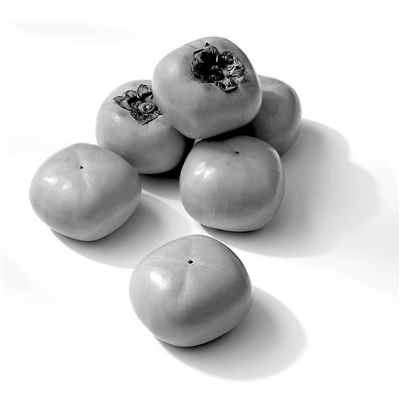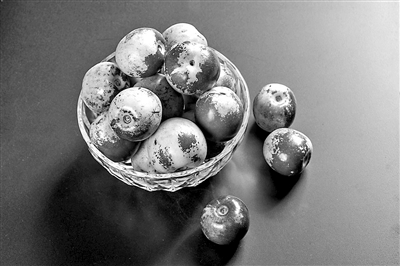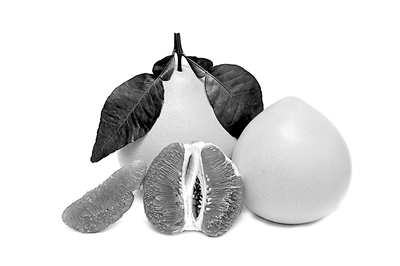


Editor’s note: Autumn is the season of bumper harvest of all kinds of fruits, and all kinds of seasonal fruits are also sold in the market. When autumn is dry, you should eat more fruits that are rich in water and have nourishing effects. There are also many eating customs in this period, such as "eating buds in summer and eating fruits in autumn". Although the fruit is good, the way to eat it is still very important. This edition selects three popular fruits in autumn to help you learn how to eat these nutritious autumn fruits healthily.
This fruit is in season, but it makes people "love and hate"! Interpretation of Several Questions about Persimmon
Autumn is full of fruitful harvest scenes. There is a folk saying that "the white dew hits walnuts, and first frost picks persimmons", and this is a good time to eat persimmons. Speaking of persimmons, the softened persimmons are thin, tender, sweet and delicious, so I really can’t help eating more. But many people stay away from it, because they heard that persimmons can’t be eaten, especially when they are eaten on an empty stomach. There is also a saying that people with anemia are not recommended to eat, which is more likely to be anemia; There are even rumors that the processed persimmon frost is a preservative. This article will take you to crack these "rumors" one by one and eat persimmons healthily and safely.
Q: Eating persimmon with stones on an empty stomach?
A: This statement is too absolute. There are other factors for stones.
Eating persimmons on an empty stomach is relatively more likely to produce stones, but the more critical factors for the formation of gastric stones are insufficient gastric motility, eating too much at a time or eating persimmons with high tannic acid for several days. If you eat astringent persimmon or ripe sweet persimmon on an empty stomach, you don’t have to worry too much about stones.
Persimmons are indeed related to gastrointestinal stones, mainly because persimmons contain more tannic acid, also called tannin, which is mainly concentrated in the peel. Its astringent taste is actually a way for plants to "protect themselves" from being eaten; Unfortunately, we humans have accepted this astringency, such as the unique flavor of wine and the heavy feeling of drinking tea, which is mainly brought by polyphenols such as tannic acid.
Suppose you eat a lot of tannic acid and enter the stomach, which polymerizes in the environment of gastric acid to form a gelatinous coagulum, and then forms a sticky mixture with protein and pectin, which slowly hardens into "stones", inducing stones and causing bloating and stomachache. If it is caused by persimmon, there is also a special name called "stomach persimmon stone"
According to the data, the appearance of "stomach persimmon stone" is related to gastrointestinal diseases (accompanied by weakened or disordered stomach function) or eating a lot of persimmons.
Of course, your stomach moves normally, and it is difficult to give tannic acid a chance to fully contact other food ingredients to "aggregate into a ball". Moreover, the persimmon varieties produced in agriculture are already low in tannic acid. We should know that the appearance of gastrolith is influenced by many factors, such as patients with a history of gastric surgery, diabetes, mental disorders, and acid-related diseases such as peptic ulcer and reflux esophagitis are also closely related.
Therefore, when diagnosing stones, we only care about persimmon intake, which is not comprehensive and needs comprehensive analysis.
Q: Pregnant women can’t eat persimmons?
A: It is purely a rumor.
As long as it is safe and hygienic, and it is not allergic to persimmons, it can be safely eaten. As long as the gastrointestinal function is normal, it is no problem to eat persimmons occasionally. Just follow the same precautions as before.
Q: People with anemia can’t eat persimmons?
A: Generally, it only appears in people who are vegetarian or eat a lot of persimmons.
As for the saying that "anemia can’t eat persimmons", I think tannic acid will affect the absorption of iron. Theoretically speaking, this phenomenon will only occur among vegetarians, and it is a long-term consumption of persimmons. Because only non-heme iron existing in plants will be affected by tannic acid, and the absorption rate of heme iron in animals will not be reduced because of tannic acid. Therefore, for most people, eating persimmons occasionally will not cause anemia.
For people with anemia, it is more important to know what causes anemia, rather than simply staying on the surface of "do you want to eat persimmons?" If it is a common iron deficiency anemia, eat more animal liver, animal blood and lean meat to increase iron intake, and supplement iron preparations when necessary.
Q: Is persimmon rich in nutrients?
A: Vitamin C is 10 times that of apples.
Persimmon is an out-and-out Chinese native fruit. Next, what is its nutritional value?
1. high vitamin c content
To say its biggest nutritional advantage, it is really not the golden color of persimmon that we thought would supplement carotene more, but vitamin C. A big crisp persimmon, about 200g each, can meet 60% of the daily demand for vitamin C (the recommended daily intake of vitamin C for healthy adults is 100mg), which is 10 times the vitamin C content of apples.
Compared with citrus family fruits with high vitamin C content, it is not inferior (persimmon 30 mg /100 g), such as orange 33 mg /100 g and tangerine 19 mg /100 g.
2. Carotene is good
The carotene content in persimmon is 120 micrograms per 100 grams, which is similar to that of orange, although it can’t catch up with mango. Like persimmon, the carotene content has more than tripled, which is equivalent to persimmon dehydration, and the nutrients in it have been concentrated.
β which is rich in carotene; -Carotene, which can be converted into vitamin A in the body, plays a very important role in eyes and skin.
3. It contains water-soluble dietary fiber such as pectin, which is helpful for relaxing bowels.
4. Moderate calories, equivalent to litchi and pomegranate.
However, persimmon can be as high as 255 kilocalories per 100 grams, which is higher than steamed bread (236 kilocalories /100 grams). Therefore, it should be noted that people who lose weight or control blood sugar should pay attention to eating less.
Q: Is the frost on persimmon a preservative?
A: Generally speaking, it is the frosting naturally formed during the production process.
Persimmons are often processed into persimmons because they are not resistant to storage, inconvenient to store and transport, and have short shelf life. To be processed into persimmon, you must peel it first. After peeling, the water inside the fruit is mixed with sugar and seeps to the surface. As the water evaporates during drying, the sugar of persimmon gradually crystallizes and accumulates on the surface, eventually separating out sugar such as glucose and fructose. In this way, persimmon with "white frost" was finally formed.
Therefore, the frost on persimmon is not a preservative, but a naturally formed frosting in the production process of persimmon, which is harmless to human body and can be safely eaten. Of course, we should be wary of some unscrupulous merchants who artificially sprinkle flour, starch and other substances on persimmon in order to improve the value of persimmon.
This is easy to distinguish. After "artificial whitening", the persimmon cake looks more evenly white. When you shake it gently with your hand, the white powder will fall off, which is fake. And its taste is not as sweet as the original persimmon.
Pay attention to the following three points and eat persimmons with confidence.
1. Don’t eat raw persimmons, and don’t eat persimmon skins. Choose fully ripe persimmons to eat without skins or choose sweet persimmons and dried persimmons. If the persimmon you bought is astringent, you can put it together with bananas and apples, put it in a plastic bag, or put it directly in a foam box, which can remove the astringency well.
2. The elderly and children with poor gastrointestinal function, who have gastroesophageal reflux and bloating, had better not eat on an empty stomach.
3. Don’t eat too many persimmons. According to statistics, eating two persimmons (400-500g) a day by healthy adults will not cause stomach stones, so children can just taste them. However, the situation varies from person to person, mainly depending on your gastrointestinal feeling. If you eat persimmon, your stomach will be uncomfortable, which means that your stomach and intestines are delicate, so don’t eat too reluctantly.
To sum up the knowledge points: eating persimmons on an empty stomach is easy to grow stones, and it cannot be generalized. The key factors for the formation of gastric stones are insufficient gastric motility and eating persimmons with high tannic acid for several days at a time. As long as the gastrointestinal function is normal, adults, pregnant women and people with anemia can eat persimmons; It is no problem for adults to eat one or two a day. Persimmons are concentrated in essence and can be eaten in half. The "white frost" you see is naturally formed icing, so you can eat it with confidence.
Text/Wang Yanli (registered dietitian)
Audit/Chen Ran (Senior Engineer, Deputy Research Librarian, COFCO Institute of Nutrition and Health)
The article is specially contributed by "Science _ Facts", please indicate the source for reprinting.
Autumn fresh jujube is on the market, why is it called "nutrition all-around champion"?
Who is the "nutrition all-around champion" in fruits? This honor, the most should be awarded to fresh jujube, people who want to maintain immunity should eat it quickly.
Fresh dates are rich in nutrients, especially vitamin C.
Fresh jujube is rich in vitamin C, B vitamins, dietary fiber, potassium and other minerals as well as a variety of organic acids, and its nutrition is very rich and comprehensive. In particular, the content of vitamin C is particularly high, up to 243 mg /100 g, and eating 40 g of fresh dates can meet the demand for vitamin C for one day. You may not have an intuitive feeling if you just say the value. When you supplement vitamin C, you may think of oranges, lemons, etc., and the vitamin C content in fresh dates is 7 times that of oranges, 10 times that of grapes, 11 times that of lemons and 20 times that of pomegranates. It is no wonder that fresh dates are called "the king of vitamin C" among common fruits.
The temperature difference between autumn and winter is large, and colds are easy to occur. For people with insufficient intake of vitamin C, proper vitamin C supplementation can maintain the body’s immunity. If vitamin C is lacking for a long time, it will make the important cells of the immune system — — The function of phagocytes is affected, and people are more likely to catch a cold, and are more prone to burnout and general fatigue.
For the average adult, the daily intake of vitamin C is 100mg/day, and the intake for preventing non-communicable chronic diseases is 200mg/day.
However, when eating fresh dates, be sure to choose fresh ones, because vitamin C is a water-soluble vitamin. In the process of water loss, vitamin C is also greatly lost, and the nutritional value of dried dates is not as good as that of fresh dates.
In addition to vitamin C, fresh dates also contain many nutrients, and the potassium content is 375 mg /100 g, which is higher than that of bananas, which is good for protecting blood vessels and preventing hypertension.
In addition, the content of carotene and zinc in fresh jujube is also high, which has the functions of antioxidation and skin protection.
Not only that, jujube also contains triterpenoids, vitamin P, adenosine cyclophosphate, etc. These substances have the function of assisting cancer prevention.
Fresh dates are sweet. Can diabetics eat them?
If the blood sugar control is stable, you can eat it, but don’t eat too much.
The sugar content of fresh dates is high, reaching 30.5%, which is higher than that of ordinary fruits. Diabetic patients can eat a few at a time, and it can be tasted. Excessive consumption will cause blood sugar fluctuations.
How much is better to eat fresh dates every day?
For the average adult, the simplest way to measure it is to grab a handful by hand every day, eat as much as you can, and try to eat between meals so as not to affect your appetite.
Eat jujube carefully and slowly, and chew the outer skin before eating it, because jujube skin is not easy to digest, especially for patients with gastrointestinal diseases. If you eat it too fast, it may increase gastrointestinal discomfort.
Text/Yu Kang (Professor of Clinical Nutrition, Peking Union Medical College Hospital)
Grapefruit is full of treasures, and grapefruit skin also has three wonderful uses.
The fruit period of grapefruit is from September to December, and it is one of the favorite fruits in autumn. Grapefruit is crisp and tender, juicy and sweet, and rich in water, which can replenish water for the body and make people unable to stop eating it. Grapefruit is not only rich in nutrition, but also a good thing.
Grapefruit is rich in vitamins and minerals, and its glycemic index is not high, so it is suitable for diabetics.
Grapefruit is rich in vitamins and minerals, including vitamins such as vitamin B1, vitamin B2, vitamin C and carotene, and minerals such as calcium, phosphorus and potassium.
Every 100g of grapefruit edible part contains 84.8g of water, 12.2g of carbohydrate, 0.7g of protein, 0.6g of fat and 0.8g of crude fiber, and contains 57 kilocalories.
Grapefruit also contains a variety of micronutrients, including a variety of minerals, such as calcium 41 mg, phosphorus 43 mg, iron 0.9 mg; There are also many vitamins, such as carotene 0.12 mg, riboflavin 0.02 mg and niacin 0.5 mg.
As a natural antioxidant, vitamin C in grapefruit pulp can resist oxidation and lower blood sugar by scavenging free radicals in the body. The glycemic index (GI value) of grapefruit is 25, and the glycemic load (GL value) is 2. It can be seen that grapefruit is low in sugar content and suitable for diabetics.
Grapefruit peel is also a good thing to help reduce blood viscosity and reduce thrombosis.
Citrus grandis peel contains flavonoids such as naringin and rutin, which have antioxidant activity, can reduce blood viscosity and reduce the formation of thrombosis, and has a good preventive effect on cardiovascular and cerebrovascular diseases such as cerebral thrombosis and stroke.
Grapefruit has the function of lowering blood sugar because it contains many phytochemicals, but some of these phytochemicals exist in the inedible part of grapefruit — — Grapefruit peel. Pomelo peel has three major nutrients.
1. Natural pigments
Pigments in grapefruit peel include fat-soluble carotenoids and water-soluble yellow flavonoids.
Naringin, the main component of water-soluble pigment, is a kind of polyphenol existing in grapefruit peel, which has antioxidant and hypoglycemic effects.
2. Dietary fiber
Grapefruit peel is rich in dietary fiber, among which water-soluble dietary fiber has the effect of improving intestinal peristalsis and lowering blood sugar.
3. Pomelo peel pectin
Pomelo peel pectin is a kind of compound polysaccharide with straight chain and high molecular chain, which has the effect of reducing low density lipoprotein cholesterol, reducing the damage of arterial wall and lowering blood sugar.
Pomelo peel can be eaten or skillfully used in three recommended ways.
Grapefruit peel is green and slightly bitter, with a unique taste. Especially the pomelo peel of Shatian pomelo in Guangxi is thick, full, white and fragrant.
When eating grapefruit skin, you need to remove the yellowish skin and the floc tightly wrapped with pulp, leaving the soft part in the middle. Pomelo peel has three wonderful uses.
1. Soak in water to lower blood sugar
Diabetic patients should make full and comprehensive use of all parts of grapefruit if they want to lower their blood sugar through grapefruit. For example, the pomelo peel is soaked in water, and the pomelo peel is diced, and 15-20 pieces are put in water at 25-70℃ for 10 minutes at a time.
Step 2 cook
Pomelo peel is mixed with meat to make pomelo-flavored steamed pork, pomelo-flavored braised pork, pomelo-flavored pork pot, pomelo-flavored steamed pork ribs, etc. The pomelo flavor and meat flavor permeate each other, which has a unique flavor and can also play a role in dissolving greasy and helping digestion.
3. Natural deodorant
Pomelo peel has a porous structure, which can purify and adsorb formaldehyde in the air. Put the pomelo peel in the refrigerator, and the mixed odor of food will not only be removed, but only a faint grapefruit fragrance will be left.
Putting the dried pomelo peel into shoes can also deodorize and sterilize. The odor of sewers in kitchens and bathrooms can also be removed by washing and soaking with boiled pomelo peel water, which is simple and practical.
Text/Dr. Ma Health Mission Dr. Guo Xiaohui
Science Audit/Ma Guansheng (Professor, Peking University School of Public Health)